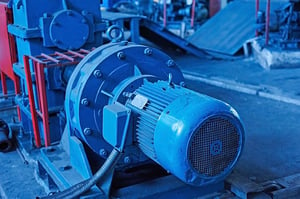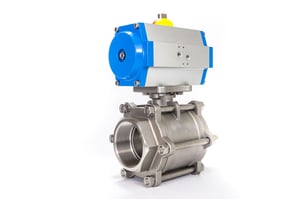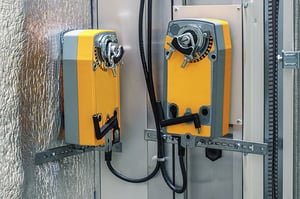What is an Actuator?
An actuator is the main component of a mechanical device that allows the device to move. This movement can be in two forms, one being linear the other being rotary. Linear movement means it can move back and forth on a set path in a straight motion. Rotary movement means movement in a rotational fashion. These two types of movement allow for actuators to be broken down into a linear actuator and a rotary actuator.
 Linear actuators straight path movement allow for both push and pull movements. This pushing and pulling movement allows for linear actuators to lift, drop, slide, adjust, tilt, push or pull objects. With the basic ability to perform these movements linear actuators can be found in multiple automation applications. Robotics use them for the ability to control repetitive movements, control rate of acceleration and deceleration, and control the amount of force applied. Manufacturing facilities ventilation systems are starting to make use of linear actuators to open and close heavy windows and doors. Solar panels have them attached to the panels to easily move them to face the sun.
Linear actuators straight path movement allow for both push and pull movements. This pushing and pulling movement allows for linear actuators to lift, drop, slide, adjust, tilt, push or pull objects. With the basic ability to perform these movements linear actuators can be found in multiple automation applications. Robotics use them for the ability to control repetitive movements, control rate of acceleration and deceleration, and control the amount of force applied. Manufacturing facilities ventilation systems are starting to make use of linear actuators to open and close heavy windows and doors. Solar panels have them attached to the panels to easily move them to face the sun.
Rotary actuators are not only different from linear actuators through the type of movement they produce, but also due to them not being on a set path. A rotary actuator can keep rotating in the same direction for as long as necessary. This type of continuous rotational movement allows for rotary actuators to power heavy machinery. It aids heavy machinery in mixing, dumping, screw clamping, turning over, and providing constant tension.
There are additional types of actuators as well. Linear and rotary will always be at the core of actuators depending on the type of movement they provide. But there are three other types of actuators that vary based on how the control signal and power source is provided. The three main forms of control signals and source of energy are; electrical current, hydraulic fluid pressure, or pneumatic pressure. This results in electric actuators, hydraulic actuators, and pneumatic actuators. All of these types of actuators are capable of being linear or rotary.
 Electric actuators use both rotary and linear motion at the same time. The rotary motion comes from rotational movement of the motor powering the actuator. This rotary motion in turns converts electrical energy into a linear mechanical force or torque. Electric actuators are typically used for equipment like multi-turn valves, pumps, and motors. With no need for fluids to power electric actuators, they are the cleanest and most readily available forms of actuators. Plants such as wastewater treatment, power plants, food and beverage, farming and agriculture, and pulp and paper plants all use electric actuators.
Electric actuators use both rotary and linear motion at the same time. The rotary motion comes from rotational movement of the motor powering the actuator. This rotary motion in turns converts electrical energy into a linear mechanical force or torque. Electric actuators are typically used for equipment like multi-turn valves, pumps, and motors. With no need for fluids to power electric actuators, they are the cleanest and most readily available forms of actuators. Plants such as wastewater treatment, power plants, food and beverage, farming and agriculture, and pulp and paper plants all use electric actuators.
When a large amount of force is required, hydraulic actuators are the correct choice and this is due to the fluids powering hydraulic actuators, which are impossible to compress. This incompressible ability from hydraulic actuators allows for them to exert a large amount of force as well as its ability to constantly hold that force or toque. Consisting of a piston inside a hollow cylinder, fluid is sent in from an external valve. That fluid sent in from the external valve moves the piston due to the created pressure by the overwhelming fluids. Hydraulic actuators have one main downfall. Unlike the cleanliness of an electric actuator, the hydraulic fluid is the complete opposite. It will have leaks and the loss of this fluid will not only create a mess, it will lead to less efficiency as well.
 Operating in a similar fashion as the hydraulic actuator, pneumatic actuators utilize compressed air instead of fluids. This compressed air acts upon a piston or paddle to move in one direction. A counterforce consisting, of a spring or a second volume of compressed air, is applied to the opposite side of the piston or paddle to reverse or maintain the position. The use of compressed air makes pneumatic actuators highly controllable and able to repeat its motion easily. Equipment such as air compressors, packaging and production machinery, mail tubes and transportation equipment like railway and aircraft application will all make use of pneumatic actuators. However, one downfall of pneumatic actuators is their inability to maintain a constant pressure. Unlike hydraulic fluids, compressed air cannot maintain a constant pressure and consistently lose pressure overtime. Due to this loss of pressure pneumatic actuators prove to be less efficient.
Operating in a similar fashion as the hydraulic actuator, pneumatic actuators utilize compressed air instead of fluids. This compressed air acts upon a piston or paddle to move in one direction. A counterforce consisting, of a spring or a second volume of compressed air, is applied to the opposite side of the piston or paddle to reverse or maintain the position. The use of compressed air makes pneumatic actuators highly controllable and able to repeat its motion easily. Equipment such as air compressors, packaging and production machinery, mail tubes and transportation equipment like railway and aircraft application will all make use of pneumatic actuators. However, one downfall of pneumatic actuators is their inability to maintain a constant pressure. Unlike hydraulic fluids, compressed air cannot maintain a constant pressure and consistently lose pressure overtime. Due to this loss of pressure pneumatic actuators prove to be less efficient.
Actuators come in many different forms that are suitable for different needs. If the need is precision, electric actuators are the correct choice. If a high force and torque are needed, hydraulic actuators would be the go-to. Simplicity would be electric actuators. Each of the different types of actuators has their advantages and disadvantages. It all comes down to choosing an actuator that is appropriate for the needs of the mechanical device it will be a part of.
To learn about how Radwell can assist you with your product and repair needs
To learn more about Radwell International


